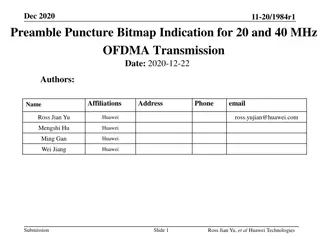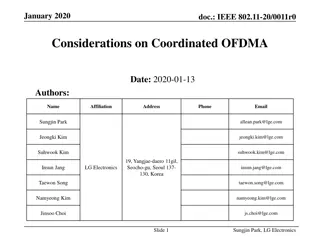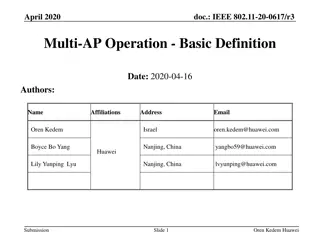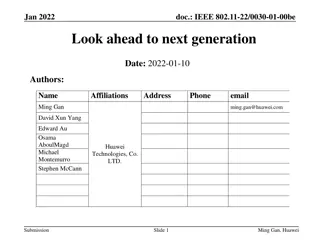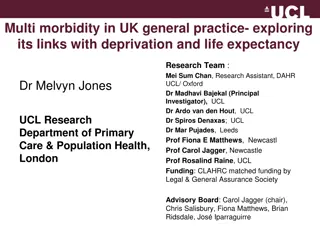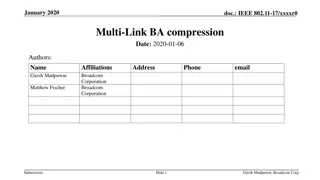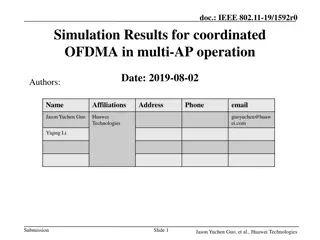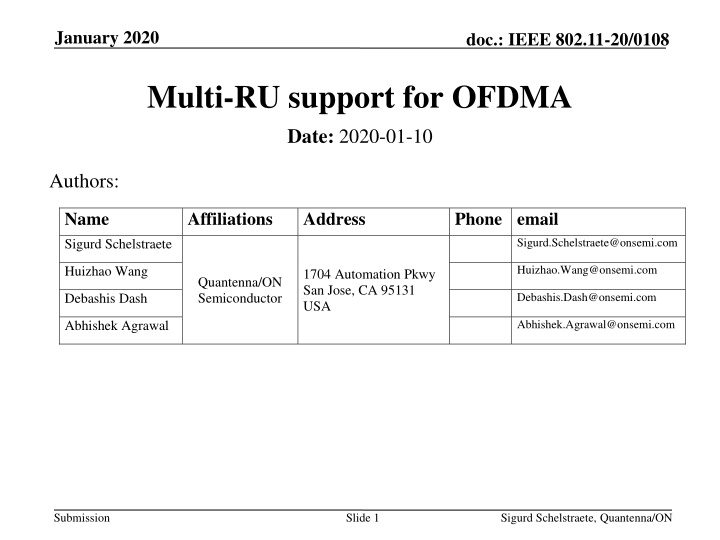
Support of Multi-RU for OFDMA in IEEE 802.11-2020
Explore the concept of supporting multiple Resource Units (RU) for Orthogonal Frequency Division Multiple Access (OFDMA) in the IEEE 802.11-2020 standard. Delve into use cases, considerations, and benefits of using multiple RUs for a single Station (STA). Understand the implications, constraints, and potential enhancements for efficient spectrum allocation and improved user experience in wireless communication networks.
Download Presentation

Please find below an Image/Link to download the presentation.
The content on the website is provided AS IS for your information and personal use only. It may not be sold, licensed, or shared on other websites without obtaining consent from the author. If you encounter any issues during the download, it is possible that the publisher has removed the file from their server.
You are allowed to download the files provided on this website for personal or commercial use, subject to the condition that they are used lawfully. All files are the property of their respective owners.
The content on the website is provided AS IS for your information and personal use only. It may not be sold, licensed, or shared on other websites without obtaining consent from the author.
E N D
Presentation Transcript
January 2020 doc.: IEEE 802.11-20/0108 Multi-RU support for OFDMA Date: 2020-01-10 Authors: Name Sigurd Schelstraete Affiliations Address Phone email Sigurd.Schelstraete@onsemi.com Huizhao.Wang@onsemi.com Huizhao Wang 1704 Automation Pkwy San Jose, CA 95131 USA Quantenna/ON Semiconductor Debashis.Dash@onsemi.com Debashis Dash Abhishek.Agrawal@onsemi.com Abhishek Agrawal Submission Slide 1 Sigurd Schelstraete, Quantenna/ON
January 2020 doc.: IEEE 802.11-20/0108 Introduction It has been agreed in principle to support multiple RUs for a single STA in 11be Open questions: How many simultaneous RUs? Any restrictions on the combination of RUs? Any restrictions on the locations of the RUs? Submission Slide 2 Sigurd Schelstraete, Quantenna/ON
January 2020 doc.: IEEE 802.11-20/0108 Use cases There are several use cases for support of multiple RUs: Non-OFDMA Motivation: Use OFDMA with multiple RUs assigned to one STA as an implementation of preamble puncturing for SU OFDMA Motivation: Increased efficiency More equitable spectrum assignment for multiple users Submission Slide 3 Sigurd Schelstraete, Quantenna/ON
January 2020 doc.: IEEE 802.11-20/0108 Preamble puncturing Sometime called non-OFDMA Still uses OFDMA format, but all RUs assigned to the same user Essentially an implementation of preamble puncturing for single user Specific constraints linked to preamble puncturing: Remove a sizeable ( 20 MHz) part of the spectrum from transmission Coarse granularity of RUs Mostly concerned with large RUs sizes Submission Slide 4 Sigurd Schelstraete, Quantenna/ON
January 2020 doc.: IEEE 802.11-20/0108 OFDMA considerations Considerations for (true) OFDMA may be different This submission will focus on the OFDMA case One observation is that the current single-RU structure is mostly optimized for 2, 4, 8, 16 users (assuming equal rates) 11ax RU allocation is inflexible and sometimes inefficient for other cases Multi-RU support could allow more efficient support for other values of the number of users See examples on next slides Submission Slide 5 Sigurd Schelstraete, Quantenna/ON
January 2020 doc.: IEEE 802.11-20/0108 OFDMA for 2, 4 and 8 users 0 1 2 3 4 5 6 7 8 9 10 11 12 13 14 15 16 17 18 19 20 21 22 23 24 25 26 27 28 29 30 31 32 33 34 35 36 0 1 2 3 4 5 6 7 8 9 10 11 12 13 14 15 16 17 18 19 20 21 22 23 24 25 26 27 28 29 30 31 32 33 34 35 36 26 26 26 26 26 26 26 26 26 26 26 26 26 26 26 26 26 26 13 13 26 26 26 26 26 26 26 26 26 26 26 26 26 26 26 26 26 26 26 26 26 26 26 26 26 26 26 26 26 26 26 26 26 26 26 26 13 13 26 26 26 26 26 26 26 26 26 26 26 26 26 26 26 26 26 26 52 52 26 52 52 52 52 26 52 52 13 13 52 52 26 52 52 52 52 26 52 52 52 52 26 52 52 52 52 26 52 52 13 13 52 52 26 52 52 52 52 26 52 52 106 26 106 106 26 106 13 13 106 26 106 106 26 106 106 26 106 106 26 106 13 13 106 26 106 106 26 106 242 242 13 13 242 242 242 242 13 13 242 242 484 13 13 484 484 13 13 484 996 996 0 1 2 3 4 5 6 7 8 9 10 11 12 13 14 15 16 17 18 19 20 21 22 23 24 25 26 27 28 29 30 31 32 33 34 35 36 26 26 26 26 26 26 26 26 26 26 26 26 26 26 26 26 26 26 13 13 26 26 26 26 26 26 26 26 26 26 26 26 26 26 26 26 26 26 52 52 26 52 52 52 52 26 52 52 13 13 52 52 26 52 52 52 52 26 52 52 106 26 106 106 26 106 13 13 106 26 106 106 26 106 242 242 13 13 242 242 484 13 13 484 996 Fairly efficient Minimal inefficiencies in spectrum Easy to allocate equal BW to all users Submission Slide 6 Sigurd Schelstraete, Quantenna/ON
January 2020 doc.: IEEE 802.11-20/0108 OFDMA for three users Without multiple RUs: 0 1 2 3 4 5 6 7 8 9 10 11 12 13 14 15 16 17 18 19 20 21 22 23 24 25 26 27 28 29 30 31 32 33 34 35 36 26 26 26 26 26 26 26 26 26 26 26 26 26 26 26 26 26 26 13 13 26 26 26 26 26 26 26 26 26 26 26 26 26 26 26 26 26 26 52 52 26 52 52 52 52 26 52 52 13 13 52 52 26 52 52 52 52 26 52 52 106 26 106 106 26 106 13 13 106 26 106 106 26 106 242 242 13 13 242 242 484 13 13 484 996 One RU has double the BW as the other two Provided total BW is used efficiently Use multi-RU to improve flexibility in spectrum allocation Submission Slide 7 Sigurd Schelstraete, Quantenna/ON
January 2020 doc.: IEEE 802.11-20/0108 Possible allocations with multi-RU 0 1 2 3 4 5 6 7 8 9 10 11 12 13 14 15 16 17 18 19 20 21 22 23 24 25 26 27 28 29 30 31 32 33 34 35 36 More even distribution of spectrum Contiguous/near- contiguous allocation Max 2 RUs 26 26 26 26 26 26 26 26 26 26 26 26 26 26 26 26 26 26 13 13 26 26 26 26 26 26 26 26 26 26 26 26 26 26 26 26 26 26 52 52 26 52 52 52 52 26 52 52 13 13 52 52 26 52 52 52 52 26 52 52 106 26 106 106 26 106 13 13 106 26 106 106 26 106 242 242 13 13 242 242 484 13 13 484 996 0 1 2 3 4 5 6 7 8 9 10 11 12 13 14 15 16 17 18 19 20 21 22 23 24 25 26 27 28 29 30 31 32 33 34 35 36 Further improved distribution of spectrum non-contiguous allocation Max 2 RUs 26 26 26 26 26 26 26 26 26 26 26 26 26 26 26 26 26 26 13 13 26 26 26 26 26 26 26 26 26 26 26 26 26 26 26 26 26 26 52 52 26 52 52 52 52 26 52 52 13 13 52 52 26 52 52 52 52 26 52 52 106 26 106 106 26 106 13 13 106 26 106 106 26 106 242 242 13 13 242 242 484 13 13 484 996 0 1 2 3 4 5 6 7 8 9 10 11 12 13 14 15 16 17 18 19 20 21 22 23 24 25 26 27 28 29 30 31 32 33 34 35 36 Further improved distribution of spectrum Contiguous/near- contiguous allocation Max 3 RUs 26 26 26 26 26 26 26 26 26 26 26 26 26 26 26 26 26 26 13 13 26 26 26 26 26 26 26 26 26 26 26 26 26 26 26 26 26 26 52 52 26 52 52 52 52 26 52 52 13 13 52 52 26 52 52 52 52 26 52 52 106 26 106 106 26 106 13 13 106 26 106 106 26 106 242 242 13 13 242 242 484 13 13 484 996 Submission Slide 8 Sigurd Schelstraete, Quantenna/ON
January 2020 doc.: IEEE 802.11-20/0108 OFDMA for five users Without multiple RUs: 0 1 2 3 4 5 6 7 8 9 10 11 12 13 14 15 16 17 18 19 20 21 22 23 24 25 26 27 28 29 30 31 32 33 34 35 36 26 26 26 26 26 26 26 26 26 26 26 26 26 26 26 26 26 26 13 13 26 26 26 26 26 26 26 26 26 26 26 26 26 26 26 26 26 26 52 52 26 52 52 52 52 26 52 52 13 13 52 52 26 52 52 52 52 26 52 52 106 26 106 106 26 106 13 13 106 26 106 106 26 106 242 242 13 13 242 242 484 13 13 484 996 Three RUs have double the BW as the other two Provided total BW is used efficiently Submission Slide 9 Sigurd Schelstraete, Quantenna/ON
January 2020 doc.: IEEE 802.11-20/0108 Possible allocations with multi-RU 0 1 2 3 4 5 6 7 8 9 10 11 12 13 14 15 16 17 18 19 20 21 22 23 24 25 26 27 28 29 30 31 32 33 34 35 36 More even distribution of spectrum Contiguous/near- contiguous allocation Max 2 RUs Some minor inefficiencies 26 26 26 26 26 26 26 26 26 26 26 26 26 26 26 26 26 26 13 13 26 26 26 26 26 26 26 26 26 26 26 26 26 26 26 26 26 26 52 52 26 52 52 52 52 26 52 52 13 13 52 52 26 52 52 52 52 26 52 52 106 26 106 106 26 106 13 13 106 26 106 106 26 106 242 242 13 13 242 242 484 13 13 484 996 0 1 2 3 4 5 6 7 8 9 10 11 12 13 14 15 16 17 18 19 20 21 22 23 24 25 26 27 28 29 30 31 32 33 34 35 36 Further improved distribution of spectrum Contiguous/near- contiguous allocation Max 3 RUs Inefficiencies reduced 26 26 26 26 26 26 26 26 26 26 26 26 26 26 26 26 26 26 13 13 26 26 26 26 26 26 26 26 26 26 26 26 26 26 26 26 26 26 52 52 26 52 52 52 52 26 52 52 13 13 52 52 26 52 52 52 52 26 52 52 106 26 106 106 26 106 13 13 106 26 106 106 26 106 242 242 13 13 242 242 484 13 13 484 996 Submission Slide 10 Sigurd Schelstraete, Quantenna/ON
January 2020 doc.: IEEE 802.11-20/0108 OFDMA for six users Without multiple RUs: 0 1 2 3 4 5 6 7 8 9 10 11 12 13 14 15 16 17 18 19 20 21 22 23 24 25 26 27 28 29 30 31 32 33 34 35 36 26 26 26 26 26 26 26 26 26 26 26 26 26 26 26 26 26 26 13 13 26 26 26 26 26 26 26 26 26 26 26 26 26 26 26 26 26 26 52 52 26 52 52 52 52 26 52 52 13 13 52 52 26 52 52 52 52 26 52 52 106 26 106 106 26 106 13 13 106 26 106 106 26 106 242 242 13 13 242 242 484 13 13 484 996 Two RUs have double the BW as the other four Provided total BW is used efficiently Submission Slide 11 Sigurd Schelstraete, Quantenna/ON
January 2020 doc.: IEEE 802.11-20/0108 Possible allocations with multi-RU 0 1 2 3 4 5 6 7 8 9 10 11 12 13 14 15 16 17 18 19 20 21 22 23 24 25 26 27 28 29 30 31 32 33 34 35 36 More even distribution of spectrum Contiguous/near- contiguous allocation Max 2 RUs Some minor inefficiencies 26 26 26 26 26 26 26 26 26 26 26 26 26 26 26 26 26 26 13 13 26 26 26 26 26 26 26 26 26 26 26 26 26 26 26 26 26 26 52 52 26 52 52 52 52 26 52 52 13 13 52 52 26 52 52 52 52 26 52 52 106 26 106 106 26 106 13 13 106 26 106 106 26 106 242 242 13 13 242 242 484 13 13 484 996 0 1 2 3 4 5 6 7 8 9 10 11 12 13 14 15 16 17 18 19 20 21 22 23 24 25 26 27 28 29 30 31 32 33 34 35 36 Further improved distribution of spectrum non-contiguous allocation Max 3 RUs Inefficiencies reduced 26 26 26 26 26 26 26 26 26 26 26 26 26 26 26 26 26 26 13 13 26 26 26 26 26 26 26 26 26 26 26 26 26 26 26 26 26 26 52 52 26 52 52 52 52 26 52 52 13 13 52 52 26 52 52 52 52 26 52 52 106 26 106 106 26 106 13 13 106 26 106 106 26 106 242 242 13 13 242 242 484 13 13 484 996 Submission Slide 12 Sigurd Schelstraete, Quantenna/ON
January 2020 doc.: IEEE 802.11-20/0108 Conclusions Multi-RU support provides more flexibility in equitable distribution of spectrum for any number of users Efficiency depends on number of RUs allocated per user Submission Slide 13 Sigurd Schelstraete, Quantenna/ON
January 2020 doc.: IEEE 802.11-20/0108 Contiguous vs. non-contiguous RUs It is preferred to have one encoder per user and distribute the codes bits over the RUs Modulating/demodulating the bits is not made more complex by RUs being contiguous or not However, channel feedback is provided in contiguous blocks Large gaps between RUs will lead to inefficiencies there Small gaps won t have much impact Contiguous allocation is not a must from implementation complexity point of view, but having multiple RUs in tight clusters is preferred for cases with precoding Submission Slide 14 Sigurd Schelstraete, Quantenna/ON
January 2020 doc.: IEEE 802.11-20/0108 How many RUs? When trying to provide more equal spectrum for multiple users, major improvement can be achieved with 2 RUs NOTE: this submission only considered OFDMA cases Having 3 RUs allows for further optimization in both overall BW efficiency and spectrum split Submission Slide 15 Sigurd Schelstraete, Quantenna/ON
January 2020 doc.: IEEE 802.11-20/0108 Restrictions on RU sizes For the examples shown, clear gains can be achieved by the following combinations of RUs: RU242 + RU106 RU106 + RU52 Additional improvement are achieved by adding the following combinations: RU242 + RU52 RU106 + RU26 RU106 + RU52 + RU26 RU106 + RU26 + RU26 RU106 + RU106 + RU26 RU106 + RU106 + RU52 Submission Slide 16 Sigurd Schelstraete, Quantenna/ON
January 2020 doc.: IEEE 802.11-20/0108 Conclusions We have considered multi-RU requirements for the OFDMA case Focus on improving spectrum split for number of users different from 2, 4, 8, 16 Propose to allow up to 3 RUs to be sent to a single user Propose to allow at least the following combinations: RU242 + RU106 RU106 + RU52 RU242 + RU52 RU106 + RU26 RU106 + RU52 + RU26 RU106 + RU26 + RU26 RU106 + RU106 + RU26 RU106 + RU106 + RU52 Multiple RUs should be close together , but being strictly contiguous placement is not required Submission Slide 17 Sigurd Schelstraete, Quantenna/ON
January 2020 doc.: IEEE 802.11-20/0108 Straw Poll 1 Do you agree that multi-RU for OFDMA shall support up to three RUs to be sent to same user? Y/N/A: Submission Slide 18 Sigurd Schelstraete, Quantenna/ON
January 2020 doc.: IEEE 802.11-20/0108 Straw Poll 2 Do you agree that multi-RU for OFDMA shall support at least the RU combinations listed on Slide 17? Y/N/A: Submission Slide 19 Sigurd Schelstraete, Quantenna/ON
January 2020 doc.: IEEE 802.11-20/0108 Straw Poll 3 Do you agree that multi-RU for OFDMA shall support both contiguous and non-contiguous RU combinations? Y/N/A: Submission Slide 20 Sigurd Schelstraete, Quantenna/ON
January 2020 doc.: IEEE 802.11-20/0108 References [1] Preamble puncturing and RU aggregation, IEEE 802.11-19/1869r0 [2] Multiple RU Combinations for EHT, IEEE 802.11- 19/1907r0 [3] Multi-RU Support, IEEE 802.11-19/1908r0 Submission Slide 21 Sigurd Schelstraete, Quantenna/ON

